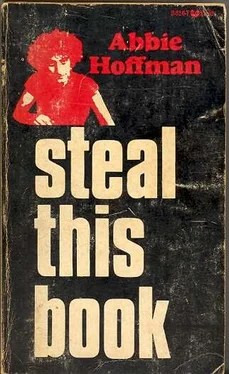Abbie Hoffman - Steal This Book
Здесь есть возможность читать онлайн «Abbie Hoffman - Steal This Book» весь текст электронной книги совершенно бесплатно (целиком полную версию без сокращений). В некоторых случаях можно слушать аудио, скачать через торрент в формате fb2 и присутствует краткое содержание. Год выпуска: 1971, Жанр: Контркультура, на английском языке. Описание произведения, (предисловие) а так же отзывы посетителей доступны на портале библиотеки ЛибКат.
- Название:Steal This Book
- Автор:
- Жанр:
- Год:1971
- ISBN:нет данных
- Рейтинг книги:4 / 5. Голосов: 1
-
Избранное:Добавить в избранное
- Отзывы:
-
Ваша оценка:
- 80
- 1
- 2
- 3
- 4
- 5
Steal This Book: краткое содержание, описание и аннотация
Предлагаем к чтению аннотацию, описание, краткое содержание или предисловие (зависит от того, что написал сам автор книги «Steal This Book»). Если вы не нашли необходимую информацию о книге — напишите в комментариях, мы постараемся отыскать её.
captures Hoffman’s puckish tone and became a cult classic with over 200,000 copies sold. Outrageously illustrated by R. Crumb, it nevertheless conveys a serious message to all would-be revolutionaries: You don’t have to take it anymore. “All Power to the Imagination was his credo. Abbie was the best.”
— Studs Terkel
Steal This Book — читать онлайн бесплатно полную книгу (весь текст) целиком
Ниже представлен текст книги, разбитый по страницам. Система сохранения места последней прочитанной страницы, позволяет с удобством читать онлайн бесплатно книгу «Steal This Book», без необходимости каждый раз заново искать на чём Вы остановились. Поставьте закладку, и сможете в любой момент перейти на страницу, на которой закончили чтение.
Интервал:
Закладка:
There are some cats in Connecticut broadcasting illegally with a 100-foot antenna over a thirty mile radius for hours on end and nobody gives them any trouble. Naturally if you insist upon using dirty language, issuing calls to revolution, broadcasting bombing information, interfering with above ground stations and becoming too well known, the FCC is going to try and knock you out. There are penalties that have never been handed out of up to a year in jail.
It’s possible you could get hit with a conspiracy rap, which could make it a felony, but the opinion of movement lawyers now is a warning if you’re caught once, and a possible fine with stiffer penalties possible for repeaters that are caught.
If it gets really heavy, you could still broadcast for up to 15 minutes without being pin-pointed by the FCC sleuths. By locating your equipment in a panel truck and broadcasting from a fixed roof antenna, you can make it almost impossible for them to catch you by changing positions.
There has been a variety of transmitting equipment used, and the most effective has been found to be an AM transmitter manufactured by Low Power Broadcasting Co., 520 Lincoln Highway, Frazer, Penn. 19355. Call Dick Crompton at (215 NI 4-4096. The right transmitter will run about $200. If you plan to use carrier-current transmission you’ll also need a capacitor that sells for $30.
An antenna can be made out of aluminum tubing and antenna wiring available at any TV radio supply store (see diagram). You’ll also need a good microphone that you can get for about $10. Naturally, equipment for heavier broadcasting is available if a member of your group has a license or good connections with someone who works in a large electronics supply house. Also with a good knowledge in the area you can build a transmitter for a fraction of the purchase price. You can always employ tape recorders, turntables and other broadcasting hardware depending on how much bread you have, how much stuff you have to hide (i.e., how legal your operation is) and the type of broadcasting you want to do.
It is possible to extend your range by sending a signal over the telephone lines to other transmitters which will immediately rebroadcast. Several areas in a city could be linked together and even from one city to another. Theoretically, if enough people rig up transmitters and antennas at proper locations and everyone operates on the same band, it is possible to build a nation-wide people’s network that is equally theoretically legal.
Broadcasting, it should be remembered, is a one-way transmission of information. Communications which allow you to transmit and receive are illegal without a license (ham radio).
GUERRILLA TELEVISION
There are a number of outlaw radio projects going on around the country. Less frequent, but just as feasible, is a people’s television network. Presently there are three basic types of TV systems: Broadcast, which is the sending of signals directly from a station’s transmitter to home receiver sets; Cable, where the cable company employees extremely sensitive antenna to pick up broadcast transmissions and relay them and/or they originate and send them; and thirdly, Closed Circuit TV, such as the surveillance cameras in supermarkets, banks and apartment house lobbies.
The third system as used by the pigs is of little concern, unless we are interested in not being photographed. The cameras can be temporarily knocked out of commission by flashing a bright light (flashbulb, cigarette lighter, etc.) directly in front of its lens. For our own purposes, closed-circuit TV can be employed for broadcasting rallies, rock concerts or teach-ins to other locations. The equipment is not that expensive to rent and easy to operate. Just contact the largest television or electronics store in your area and ask about it. There are also closed-circuit and cable systems that work in harmony to broadcast special shows to campuses and other institutions. Many new systems are being developed and will be in operation soon.
Cable systems as such are in use only in a relatively few areas. They can be tapped either at the source or at any point along the cable by an engineer freak who knows what to do. The source is the best spot, since all the amplification and distribution equipment of the system is available at that point. Tapping along the cable itself can be a lot hairier, but more frustrating for the company when they try to trace you down.
Standard broadcasting that is received on almost all living room sets works on an RF (radio frequency) signal sent out on various frequencies which correspond to the channels on the tuner. In no area of the country are all these channels used.
This raises important political questions as to why people do not have the right to broadcast on unused channels. By getting hold of a TV camera (Sony and Panasonic are the best for the price) that has an RF output, you can send pictures to a TV set simply by placing the camera cable on or near the antenna of the receiver set. When the set is operating on the same channel as the camera, it will show what the camera sees. Used video tape recorders such as the Sony CV series that record and play back audio and video information are becoming more available. These too can be easily adapted to send RF signals the same as a live camera.
Whether or not the program to be broadcasted is live or on tape, there are three steps to be taken in order to establish a people’s TV network. First, you must convert the video and audio signals to an RF frequency modulated (FM) signal corresponding to the desired broadcast channel. We suggest for political and technical reasons that you pick one of the unused channels in your area to begin experimenting. The commercial stations have an extremely powerful signal and can usually override your small output. Given time and experience you might want to go into direct competition with the big boys on their own channel. It is entirely possible, say in a 10 to 20 block radius, to interrupt a presidential press-conference with more important news. Electronic companies, such as Jerrold Electronics Corp., 4th and Walnut Sts., Philadelphia, Pa., make equipment that can RF both video and audio information onto specific channels. The device you’d be interested in is called a cable driver or RF modulator.
When the signal is in the RF state, it is already possible to broadcast very short distances. The second step is to amplify the signal so it will reach as far as possible. A linear amplifier of the proper frequency is required for this job. The stronger the amplifier the farther and more powerful the signal. A 10-watt job will cover approximately 5 miles (line of sight) in area. Linear amplifiers are not that easily available, but they can be constructed with some electrical engineering knowledge.
The third step is the antenna, which if the whole system is to be mobile to avoid detection, is going to involve some experimentation and possible camouflage.
Two things to keep in mind about an antenna are that it should be what is technically referred to as a “di-pole” antenna (see diagram) and since TV signals travel on line of sight, it is important to place the antenna as high as possible.
Although it hasn’t been done in practice, it certainly is possible to reflect pirate signals off an make equipment that can RF both video and audio existing antenna of a commercial network. This requires a full knowledge of broadcasting; however, any amateur can rig up an antenna, attach it to a helium balloon and get it plenty high. For most, the roof of a tall building will suffice. If you’re really uptight about your operation, the antenna can be hidden with a fake cardboard chimney.
We realize becoming TV guerrillas is not everyone’s trip, but a small band with a few grand can indeed pull it off. There are a lot of technical freaks hanging around recording studios, guitar shops, hi-fi stores and engineering schools that can be turned on to the project. By showing them the guidelines laid out here, they can help you assemble and build various components that are difficult to purchase (i.e., the linear amplifier). Naturally, by building some of the components, the cost of the operation is kept way down. Equipment can be purchased in selective electronics stores. You’ll need a camera, VTR, RF modulator, linear amplifier and antenna. Also a generator, voltage regulator and an alternator if you want the station to be mobile. One of the best sources of information on both television and radio broadcasting is the Radio Amateur’s Handbook published by the American Radio Relay League, Newington, Conn. 06611 and available for $4.50. The handbook gives a complete course in electronics and the latest information on all techniques and equipment related to broadcasting. Back issues have easy to read do-it-yourself TV transmitter diagrams and instructions. Also available is a publication called Radical Software, put out by Raindance Corp., 24 E. 22nd St., New York, N.Y., with the latest info on all types of alternative communications.
Читать дальшеИнтервал:
Закладка:
Похожие книги на «Steal This Book»
Представляем Вашему вниманию похожие книги на «Steal This Book» списком для выбора. Мы отобрали схожую по названию и смыслу литературу в надежде предоставить читателям больше вариантов отыскать новые, интересные, ещё непрочитанные произведения.
Обсуждение, отзывы о книге «Steal This Book» и просто собственные мнения читателей. Оставьте ваши комментарии, напишите, что Вы думаете о произведении, его смысле или главных героях. Укажите что конкретно понравилось, а что нет, и почему Вы так считаете.












